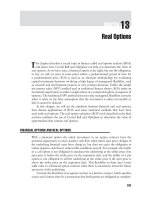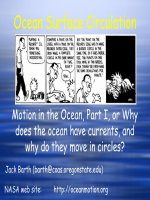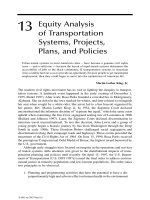Group counseling strategies and skills chapter 13
Bạn đang xem bản rút gọn của tài liệu. Xem và tải ngay bản đầy đủ của tài liệu tại đây (788.48 KB, 32 trang )
Copyright © 2012 Brooks/Cole, a division of Cengage Learning, Inc.
Using Counseling
Theories in Groups
©2016. Cengage Learning. All rights reserved.
Chapter 13
2. Taught to entire group, then members
use the theories during the group
meetings and in their daily living
2
Copyright © 2012 Brooks/Cole, a division of Cengage Learning, Inc.
1. When working with individuals
©2016. Cengage Learning. All rights reserved.
Ways Theories Are Used in Groups
©2016. Cengage Learning. All rights reserved.
Copyright © 2012 Brooks/Cole, a division of Cengage Learning, Inc.
Rational Emotive Behavior
Therapy
Thoughts cause feelings.
A-B-C Model
A=activating event (situation)
B=beliefs (thoughts or self-talk)
C=consequences
(feelings/emotions)
“B” ties “C” to “A”
3
4
Copyright © 2012 Brooks/Cole, a division of Cengage Learning, Inc.
Identify faulty or irrational thoughts at
“B”.
Challenge or Dispute these thoughts or
beliefs.
Establish more rational or accurate
thoughts that lead to less intense negative
emotions.
Teach the process to members.
©2016. Cengage Learning. All rights reserved.
Using REBT in Groups
Copyright © 2012 Brooks/Cole, a division of Cengage Learning, Inc.
©2016. Cengage Learning. All rights reserved.
Teaching REBT to Members
Use A-B-C Model
Ask “where do feelings come from?”
Use examples
– School grades—students getting same grade but
have different feelings
5
Copyright © 2012 Brooks/Cole, a division of Cengage Learning, Inc.
©2016. Cengage Learning. All rights reserved.
Aides in Teaching
Use whiteboard to make it visual
Use list of irrational sentences of adults
Use list of irrational sentences of kids
6
Copyright © 2012 Brooks/Cole, a division of Cengage Learning, Inc.
©2016. Cengage Learning. All rights reserved.
Using REBT in Groups
Clarifying the event, person or situation
(A)
Clarifying feelings and/or behavior (C)
Clarifying negative self-talk (B)
Changing the feelings by changing the
self-talk
7
Copyright © 2012 Brooks/Cole, a division of Cengage Learning, Inc.
©2016. Cengage Learning. All rights reserved.
Using REBT in Groups
Leader can focus on one member’s
problem
– Leader and member’s use the theory to help
member change his or her self-talk
Leader can focus on all members
and use REBT
– Example: “When you get angry, what is it
that you tell yourself?”
8
Copyright © 2012 Brooks/Cole, a division of Cengage Learning, Inc.
©2016. Cengage Learning. All rights reserved.
Reality Therapy
Human beings are responsible for making
choices about their behavior.
Five basic needs:
survival
love and belonging
power (achievement)
freedom (to make life decisions)
fun
9
Copyright © 2012 Brooks/Cole, a division of Cengage Learning, Inc.
©2016. Cengage Learning. All rights reserved.
Basic Components of Behavior
Acting
Thinking
Feeling
10
Copyright © 2012 Brooks/Cole, a division of Cengage Learning, Inc.
©2016. Cengage Learning. All rights reserved.
Emphasis on Doing
Often members find it easier to act or do
something different than to change
thoughts or feelings; therefore, focus is
on doing
11
12
Copyright © 2012 Brooks/Cole, a division of Cengage Learning, Inc.
Want---what do you really want?
Doing---what are you doing to get you
what you want?
Evaluation---is your behavior working?
Planning---let’s develop a “doable” plan to
get you what you want
©2016. Cengage Learning. All rights reserved.
WDEP-Components of Change
Copyright © 2012 Brooks/Cole, a division of Cengage Learning, Inc.
©2016. Cengage Learning. All rights reserved.
Using WDEP
Use it with one member and other
members help that member using the
WDEP model
Use it with all members at the same time
– Example: “Each of you think of something that you
really want . . .”
13
Copyright © 2012 Brooks/Cole, a division of Cengage Learning, Inc.
©2016. Cengage Learning. All rights reserved.
Value of Using Reality Therapy
Members will remember the WDEP model
and can apply it in many situations
Members can help other members work
through the WDEP model
Members connect how their basic needs
play a major role in their lives
14
Copyright © 2012 Brooks/Cole, a division of Cengage Learning, Inc.
©2016. Cengage Learning. All rights reserved.
Adlerian Therapy
ALL BEHAVIOR IS PURPOSEFUL.
Everyone has “private logic.”
– Mistaken goals
– Guiding fictions
Birth order has a major influence on
personality development.
Perceived feelings of inferiority lead
children to strive toward perfection and to
compete with siblings and others.
15
Copyright © 2012 Brooks/Cole, a division of Cengage Learning, Inc.
©2016. Cengage Learning. All rights reserved.
Goals of Adlerian Therapy
Help members identify childhood
experiences that formulated mistaken
goals and guiding fictions.
Help members discover how they
continue to act out roles played in the
family.
Help members develop new behaviors
more congruent with happy adult living.
16
17
Copyright © 2012 Brooks/Cole, a division of Cengage Learning, Inc.
Have members discuss in detail the
influence of their birth order
Have members discuss how they found
their place in their families and how that
plays out now
Have members share early recollections
and how they may influence behavior now
©2016. Cengage Learning. All rights reserved.
Adlerian Group Activities
Copyright © 2012 Brooks/Cole, a division of Cengage Learning, Inc.
©2016. Cengage Learning. All rights reserved.
Transactional Analysis
Everyone has three ego states:
Parent
Adult
Child
18
Copyright © 2012 Brooks/Cole, a division of Cengage Learning, Inc.
©2016. Cengage Learning. All rights reserved.
Using TA in Groups
Egograms help identify dominant ego
states.
__________________________________
CP
Other
CP
Self
NP
Other
NP
Self
Adult
Free
Child
Not OK
Child
19
Copyright © 2012 Brooks/Cole, a division of Cengage Learning, Inc.
P
P
A
A
A
A
C
C
©2016. Cengage Learning. All rights reserved.
Drawing TA
PAC circles show communication
patterns.
20
21
Copyright © 2012 Brooks/Cole, a division of Cengage Learning, Inc.
Have members draw and then discuss
their egograms
Have members draw out various
transactions they have with significant
others in their lives
Have members discuss their different ego
states, especially their Child and Parent
©2016. Cengage Learning. All rights reserved.
TA Activities
Copyright © 2012 Brooks/Cole, a division of Cengage Learning, Inc.
©2016. Cengage Learning. All rights reserved.
More TA Activities
Role play situations showing how
different ego states would handle a
situation
Use a small child’s chair and have
members talk about when they “get into
that chair.”
Have members stand on a chair
representing their Parent ego state and
talk about when they get into that
position.
22
Copyright © 2012 Brooks/Cole, a division of Cengage Learning, Inc.
©2016. Cengage Learning. All rights reserved.
Using Gestalt Therapy
Focuses on the present
Members need to finish their unfinished
business
Goals include moving toward
independence, maturity, and selfactualization
23
Copyright © 2012 Brooks/Cole, a division of Cengage Learning, Inc.
©2016. Cengage Learning. All rights reserved.
Empty ChairTechniques
o
o
o
Work with one individual
Have member talk to the person in the empty chair
“Presentizing” the past
o Work with group—put chair in the middle of the
group
o Role Reversal-playing other significant person or
part
Note: Empty chair work can cause members to
have strong emotional reactions
24
Copyright © 2012 Brooks/Cole, a division of Cengage Learning, Inc.
©2016. Cengage Learning. All rights reserved.
Solution-Focused Therapy
Solution-focused group counseling
focuses on solutions rather than
problems
It is an approach that emphasizes the
members’ strengths
25









